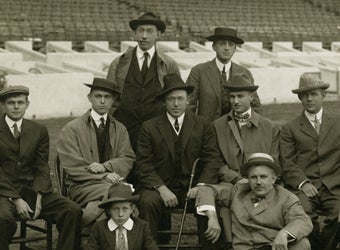2014 Changes to Voting Process
Hall of Fame Announces Changes to Voting Process for Recently Retired Players, Effective Immediately
Length of Stay, Balloting Process Highlight Board Alterations to BBWAA Voting
(COOPERSTOWN, NY) – The National Baseball Hall of Fame and Museum’s Board of Directors today announced changes to the rules for election for recently retired players, reducing the length of stay on the ballot for players from a maximum of 15 to 10 years, while installing a new balloting and registration process for Baseball Writers’ Association of America voting members.
The changes, effective immediately and to be reflected in 2015 Hall of Fame voting, are the first made by the Hall of Fame to the voting process since 1991 and just the second time the Baseball Hall of Fame has amended the rules for election since 1985.
“The Board is committed to keeping the policies and voting procedures of the Hall of Fame relevant,” said Jane Forbes Clark, Chairman of the Board of the National Baseball Hall of Fame and Museum. “We believe the BBWAA has done an excellent job of honoring the criteria advanced by the Hall of Fame – player’s record, contributions to the teams on which the player played, character, sportsmanship and integrity – to determine individuals who belong in the Hall of Fame by the highest threshold, a 75 percent majority. The Board believes these changes are necessary to ensure the integrity of the voting process moving forward.”
Candidates for Hall of Fame election who receive votes on at least five percent of ballots cast had previously been eligible to remain on the ballot for a maximum of 15 years of consideration by the BBWAA. Going forward, the maximum years of consideration for a player who meets that criteria is now 10 years. Candidates would then move to the Era Committee system for review in perpetuity. Three candidates presently on the BBWAA ballot in years 10-15 will be grandfathered into this system and remain under consideration by the BBWAA for up to the full 15 years. Don Mattingly (15th year in 2015), Alan Trammell (14th year in 2015) and Lee Smith (13th year in 2015) will be eligible to remain on the BBWAA ballot for a maximum of 15 years of consideration.
BBWAA members earn a Hall of Fame vote from its organization, which is independent of the Hall of Fame, by maintaining 10 consecutive years on a baseball beat. Those Hall of Fame eligible voters will now be required to complete a registration form and sign a code of conduct. The names of those BBWAA members casting Hall of Fame ballots will now be made public with the election results; however, an individual’s ballot will not be revealed by the Hall of Fame.
Ernst and Young will continue to verify the count, with added responsibilities in verifying the process. The 2015 ballot will be announced by the BBWAA in late-November and those who have completed the registration process will receive their ballot around that time. Ballots are to be postmarked by December 31. The 2015 BBWAA Hall of Fame results will be announced at a yet to be determined date in early January.
Of the 211 players in the Hall of Fame, 115 have been elected by the BBWAA, 96 by Veterans Committees. Of the 115 BBWAA electees, 102 (89%) have been elected in years 1-10 and 13 (11%) have been elected in years 11-15.
The BBWAA has held the exclusive voting privilege to consider recently retired players for election to the National Baseball Hall of Fame since 1936. Since that time, the BBWAA has presided over 70 elections in 79 election years, with no elections being held in 1940, 1941, 1943, 1944, 1957, 1959, 1961, 1963 and 1965.
In the nascent stages of Hall of Fame voting, election rules were not codified. By World War II, they began to take shape, with evolution over ensuing years featuring changes to the eligibility criteria and qualifications for earning election. The rules for election are maintained and governed by the Hall of Fame’s Board of Directors.
The last rule change implemented by the Hall of Fame came in 1991, formalizing a long-standing unwritten rule that anyone on baseball’s ineligible list cannot be an eligible candidate for Hall of Fame election. Prior to that, in 1985, the Board made candidates eligible for future elections if they were named on five percent or more of ballots cast in preceding elections.













